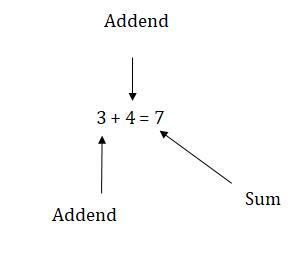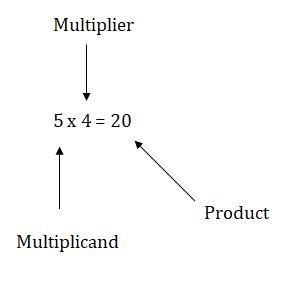
 Data Structure
Data Structure Networking
Networking RDBMS
RDBMS Operating System
Operating System Java
Java MS Excel
MS Excel iOS
iOS HTML
HTML CSS
CSS Android
Android Python
Python C Programming
C Programming C++
C++ C#
C# MongoDB
MongoDB MySQL
MySQL Javascript
Javascript PHP
PHP
- Selected Reading
- UPSC IAS Exams Notes
- Developer's Best Practices
- Questions and Answers
- Effective Resume Writing
- HR Interview Questions
- Computer Glossary
- Who is Who
Additive Identity vs Multiplicative Identity
Introduction
Additive Identity and Multiplicative Identity are two different identity properties of numbers. Addition & multiplication are basic arithmetic operations in mathematics. Addition is the process of adding things or number together whereas multiplication is the process of calculating the product of two or more numbers. It is a repetitive addition. For example, if a is multiplied by b, it means a is added itself to n times or vice versa. It is used to combine groups of equal size.
Additive identity & multiplicative identity are properties of addition & multiplication. When we added a number to other numbers, the sum of the number is the original number. When added to zero in any number result is the original number. Hence zero is the additive identity. The multiplicative identity is a value or number multiplied by another number giving the product the original number. When we multiplied any number by 1 it gives the product as the original number hence one is the multiplicative identity.
Addition
It is one of the basic arithmetic operations in mathematics.
The addition is a process of adding or summing things or numbers together.
It is denoted by the plus (+) symbol.
We can add one-digit numbers by simply counting fingers. But large numbers can be added by using a method of regrouping.
Addition can be done by using the number line.
Addition can be conducted on any type of number & algebraic expression.
Basic terminologies in addition:
Addend- Addends are the numbers that are added together.
Addition symbol (+)- This symbol is placed between two addends. It indicates the addition of two numbers.
Equal sign (=)- This sign represents equivalence relation in two addends.
Sum- A result obtained from the addition of two addends is known as a sum.
The below example will help you to understand about basic terminologies of addition

The basic formula of addition can be expressed as
$$\mathrm{Addends\:+\:Addends\:=\:Sum}$$
Additive identity
Additive identity is applied while performing addition.
It is also known as the identity property of addition.
Additive identity is a value or number that when added to any number will give the original number.
Zero is an additive identity.
If ? is any number additive property is expressed as $\mathrm{n\:+\:0\:=\:n}$
For example, $\mathrm{8\:+\:8\:=\:8\:,\:0\:+\:(-5)\:=\:-5}$
In the above example, to get the given number as the answer, we have added zero to a given number.
This property applies to all numbers, such as whole numbers, integers, complex numbers, and rational & irrational numbers.
Multiplication
It is one of the basic arithmetic operations in mathematics.
It is the process of calculating a product of two or more numbers.
Multiplication is a repetitive addition.
It is denoted by the symbol $\mathrm{(\times)}$ or dot $\mathrm{(.)}$, or sometimes it is denoted by an asterisk $\mathrm{(*)}$ sign.
Basic terminologies regarding multiplication:
Multiplicand - It is a number which is to be multiplied by another number.
Multiplier - It is the number or factor by which another number is to be multiplied.
Product - After the multiplication of multiplicand & multiplier obtained result is known as the product.
Multiplication symbol (Ã) It connects multiplicand & multiplier.
The below example will help you to understand the basic terminologies of multiplication.

The basic formula of multiplication is given as
$$\mathrm{Multiplicand\times\:Multiplier\:=\:Product}$$
Multiplicative Identity
Multiplicative property is applied while performing multiplication.
It is also known as the identity property of multiplication.
Multiplicative identity states that any number multiplied by one gives the original number.
One is the multiplicative identity.
If n be any number, then multiplicative identity for n is expressed as $\mathrm{n\times\:1\:=\:n}$
For example, $\mathrm{4\times\:1\:=\:4\:,\:4\times\:1\:=\:-4}$
This property is applicable for real numbers, complex numbers, integers & rational numbers.
Comparison between two identities
| Additive identity | Multiplicative identity |
|---|---|
| Additive identity for any number is 0. | Multiplicative identity for any number 1 |
| It is used in addition operation. | It is used in a multiplication operation |
| It is expressed in the form of $\mathrm{n\:+\:1\:=\:0}$ | It is expressed in the form $\mathrm{n\times\:1\:=\:n}$ |
| It is also known as identity property of addition | iv)It is also known as the identity property of multiplication. |
| For example, $\mathrm{9\:+\:0\:=\:9}$
$\mathrm{-9\:+\:0\:=\:-9}$ |
For example,$\mathrm{9\times\:1\:=\:9}$
$\mathrm{-9\times\:1\:=\:-9}$ |
Solved examples
1) A flock of 10 pigeons sat together on the roof of the house. After some time, not a single pigeon joined them. Using additive identity find a number of pigeons sitting on the roof.
Answer As not a single pigeon joined the flock of the pigeon, hence the number of pigeons will remain the same.
Hence, by the additive property,
$$\mathrm{10\:pigeons\:+\:0\:=\:10\:pigeons}$$
2) Find the value of b if $\mathrm{b\times\:1\:=\:125}$
Answer $\mathrm{b\times\:1\:=\:125\:.........(Given)}$
By multiplicative property, to get a given number as a product 1 is multiplied by that number
Therefore ? = 125
3) Choose the correct alternative for the following multiple-choice question.
Which of the following is an example additive property?
$\mathrm{-9\:+\:9\:=\:0}$
$\mathrm{2\:+\:3\:\neq\:3\:+\:3}$
$\mathrm{5\:+\:0\:=\:5}$
$\mathrm{7\times\:1\:=\:7}$
Answer. Option c is an example of additive property.
Conclusion
This tutorial covers the topic of additive identity & multiplicative identity in brief. In this tutorial, we have discussed addition, subtraction, additive identity & multiplicative identity with solved examples. Addition is a process of adding numbers together whereas multiplication is a process of finding a product of two or more numbers. We used commonly addition & subtraction in everyday life. Additive & multiplicative identities are used while performing addition & multiplication. The additive property states that when we add zero to any number it gives the original number as an answer. Hence zero is the additive identity.
The multiplicative property states that when we multiplied any number by one it gives the original number as a product. Therefore one is the multiplicative identity. This identity applies to all real numbers, complex numbers integers as well as rational numbers. These properties are also used in abstract algebra in rings. This tutorial will surely help you to understand the topic of additive identity & multiplicative identity in brief.
FAQs
1. What is additive inverse?
An additive inverse is a number added to the original number to yield zero. For example, ?5 is the additive inverse of 5.
2. What is multiplicative inverse?
The multiplicative inverse is a when multiplied by the original number gives the product as 1. It is also known as reciprocals.
For example, the multiplicative inverse of 9 is $\mathrm{\frac{1}{9}}$
3. Enlist properties of multiplication?
The properties of multiplication are
Associative property
Commutative property
Distributive property
Identity property
Zero property
4. Is ?? also multiplicative identity?
No. When we multiply any real number with ?1 changes sign. Hence ?1 is not a multiplicative identity.
5. What is the zero property of addition?
The zero property is also known as the property of additive identity. As per this property, if zero is added to any number, the sum is the number itself.
For example, $\mathrm{85\:+\:0\:=\:85}$

